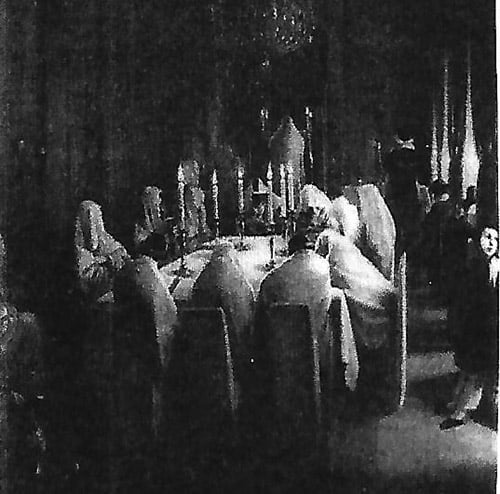
Part III
(continued from last week)
When I first read the article by Jonathan Marvin, years after I had moved out of Washington Heights, it brought back vivid memories of not only Chazan Frankel, but also the strictly enforced and coordinated movements of all the participants in the service. A whole book probably could be written on this subject, but let me give you just one example.
The scene is after leining and the sefer Torah is being brought back to the aron by the chazan. Firstly, the sefer never goes by itself, meaning the chazan does not walk by himself. Behind the chazan walks one of the gabbaim of the shul, or as we kids would call him, the strippe zieher (puller of the ribbon), but more about that later. Behind the gabbai walks the one who has hotza’a v’hachnasa (h.v.). The gabbai goes up to the aron via the steps on the left side, while the chazan, followed by the one who has h.v., goes up on the right side. As the chazan arrives on the elevated platform in front of the aron, the strippe zieher pulls the ribbon to open the paroches. (That is why we called him by that name.) As the gabbai does his job, the h.v. approaches and opens the doors of the aron, takes the sefer from the chazan and places it into the aron, making sure that by doing so he does not have to pass his sefer in front of another sefer.
In the meantime the chazan has gone to his assigned place on the platform at a 90-degree angle and next to the aron on the right side if you face the aron. The gabbai has moved to the left side of the aron and stands facing the chazan. The h.v. has moved next to the chazan. After the completion of Uvnucho Yomar, the chazan kisses the seforim with his tzitzis, followed by the gabbai and then the h.v. The h.v. closes the doors and the gabbai does his job by closing the paroches. Only when the paroches is closed does the chazan turn from the aron, goes off the platform on the left side (if you face the aron; never on the right), followed by the h.v., who is then followed by the gabbai.
This is the basic, for a regular Shabbat. There are variations, such as when there are two or three sefarim taken out, or when the rabbi is part of the group on the platform. But the above should give you an idea.
(“Why I Daven With the Yekkes,” continued from last week)
Later, I became one of the ba’alei tefila in the hashkama (early) minyan. (Only officially appointed chazanim could daven for the main minyan.) I know he disliked making recordings, but he always found time to sit with me. Was it the unique tune for the words “Vehu yashmi’aynu” in Musaf Kedusha on Shabbos Chazon? Or one of the special Kaddish tunes done throughout the year? (They say there are 64 different tunes in Nusach Frankfurt, and I wouldn’t be surprised if there are more.) Or was it the precise phrasing of the words in Birkas Krias Shema? Or perhaps all of the different modes needed for the selichos? Whatever it was, he helped me. By the way, he always had a full-time job working for Shaarei Zedek Hospital, a cause he passionately believed in. He put in all that effort, and it wasn’t even his “primary” job. But it was his life.
Only much later did I learn about his personal life, which he didn’t speak too much about. His father died when he was very young. He sang in the choir in Hamburg as a small boy, and wanted to be a chazan from his youngest days. He even heard Yossele there once, in the 1920s. His commitment to doing things correctly manifested itself as a very young boy. Some slight change was made in one of the Yom Kippur prayers one year. When the time came, he sang his part very loudly the old way, the correct way, in his seven-year-old mind, refusing to change. As I recall, he was kicked out of the choir for a while because of that.
By Norbert Strauss
Norbert Strauss is a Teaneck resident and Englewood Hospital volunteer. He frequently speaks to groups to relay his family’s escape from Nazi Germany in 1941.










